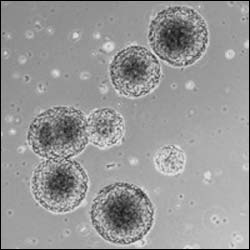Insulin-producing cells from brain cursors

Insulin-producing neurospheres. (Photo: Seung Kim et al.)
In a paper in this month’s freely-available online global health journal PLoS Medicine Seung Kim and colleagues from Stanford University suggest that one way of producing insulin-secreting pancreatic islet cells for future possible treatment of type I diabetes is to look beyond immature pancreatic cells and embryonic stem cells to other early cell types. Kim and colleagues took cells derived from brain which usually mature into neural cells, and exposed them to a series of signals that are known to drive pancreatic islet development. They were able to produce clusters of insulin-producing cells that responded to glucose out of the body.
When the cells were then transplanted into immunocompromised mice the cells could also be stimulated by glucose to produce human insulin. Future work will need to establish the long-term stability and safety of these cells and to work out how to scale up such a process to produce the much larger numbers of cells that would be needed for human treatment. However, the authors conclude that this technique “could serve as the basis for developing replacement islets from a wide range of human stem cells, including neural stem cells and ES cells.”
Media Contact
All latest news from the category: Life Sciences and Chemistry
Articles and reports from the Life Sciences and chemistry area deal with applied and basic research into modern biology, chemistry and human medicine.
Valuable information can be found on a range of life sciences fields including bacteriology, biochemistry, bionics, bioinformatics, biophysics, biotechnology, genetics, geobotany, human biology, marine biology, microbiology, molecular biology, cellular biology, zoology, bioinorganic chemistry, microchemistry and environmental chemistry.
Newest articles

Properties of new materials for microchips
… can now be measured well. Reseachers of Delft University of Technology demonstrated measuring performance properties of ultrathin silicon membranes. Making ever smaller and more powerful chips requires new ultrathin…

Floating solar’s potential
… to support sustainable development by addressing climate, water, and energy goals holistically. A new study published this week in Nature Energy raises the potential for floating solar photovoltaics (FPV)…

Skyrmions move at record speeds
… a step towards the computing of the future. An international research team led by scientists from the CNRS1 has discovered that the magnetic nanobubbles2 known as skyrmions can be…





















